RACING BRAKE BOOK

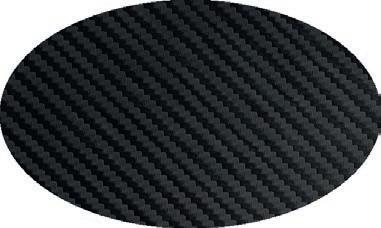

WINS
Unmatched & greatest of All Time

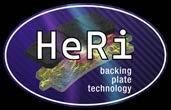
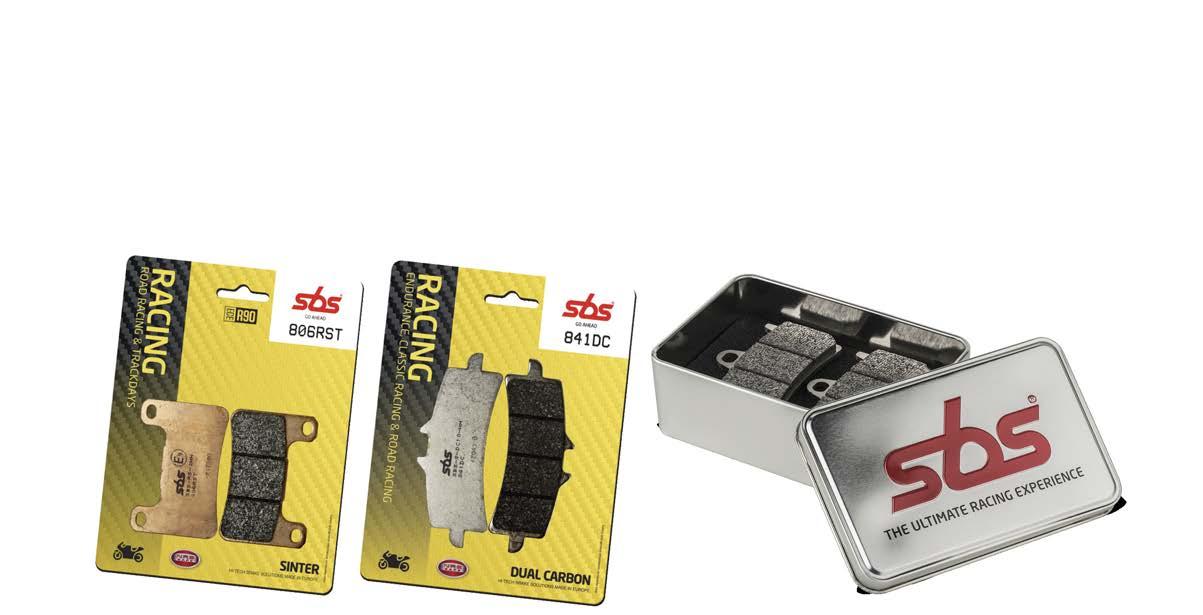
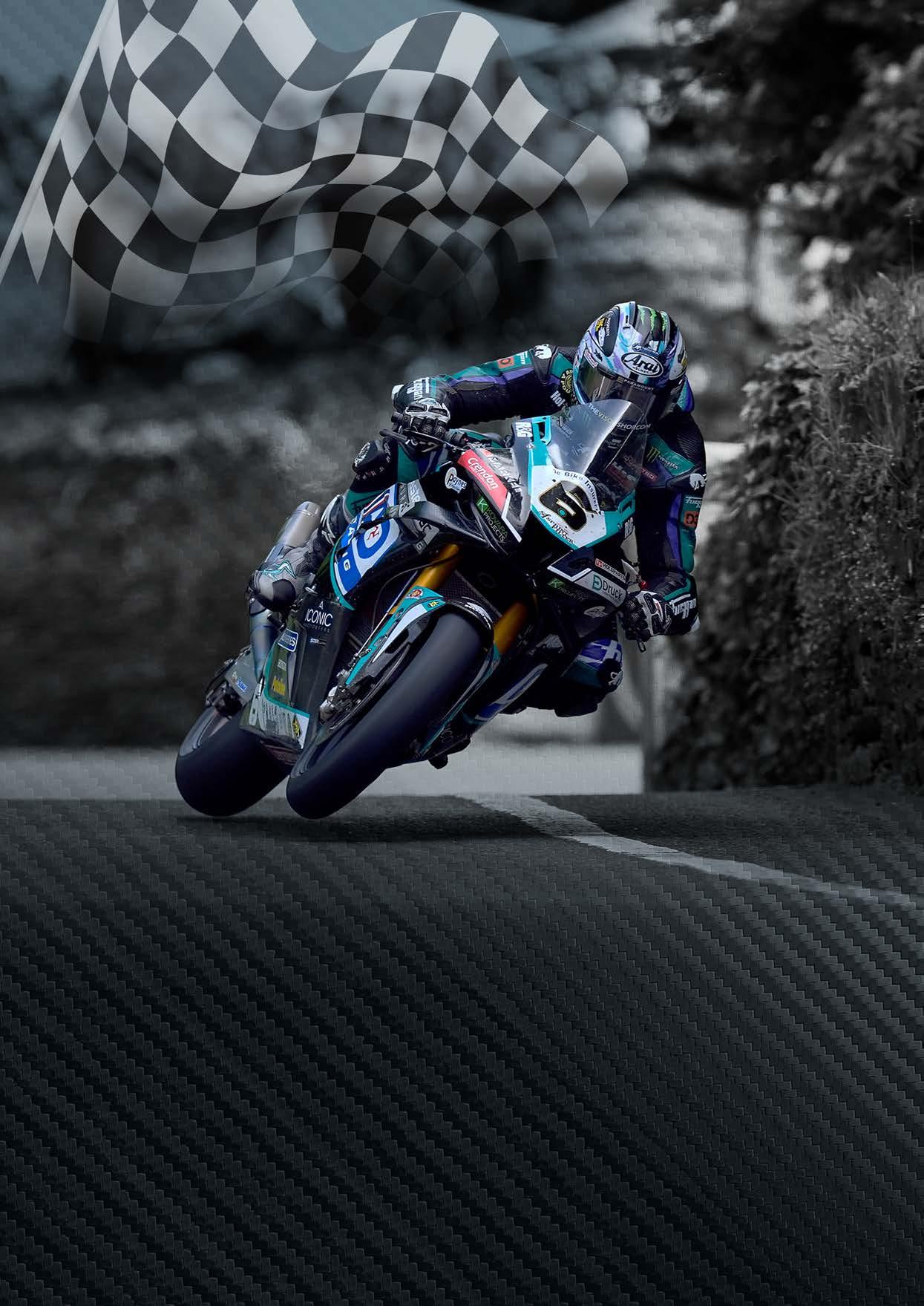
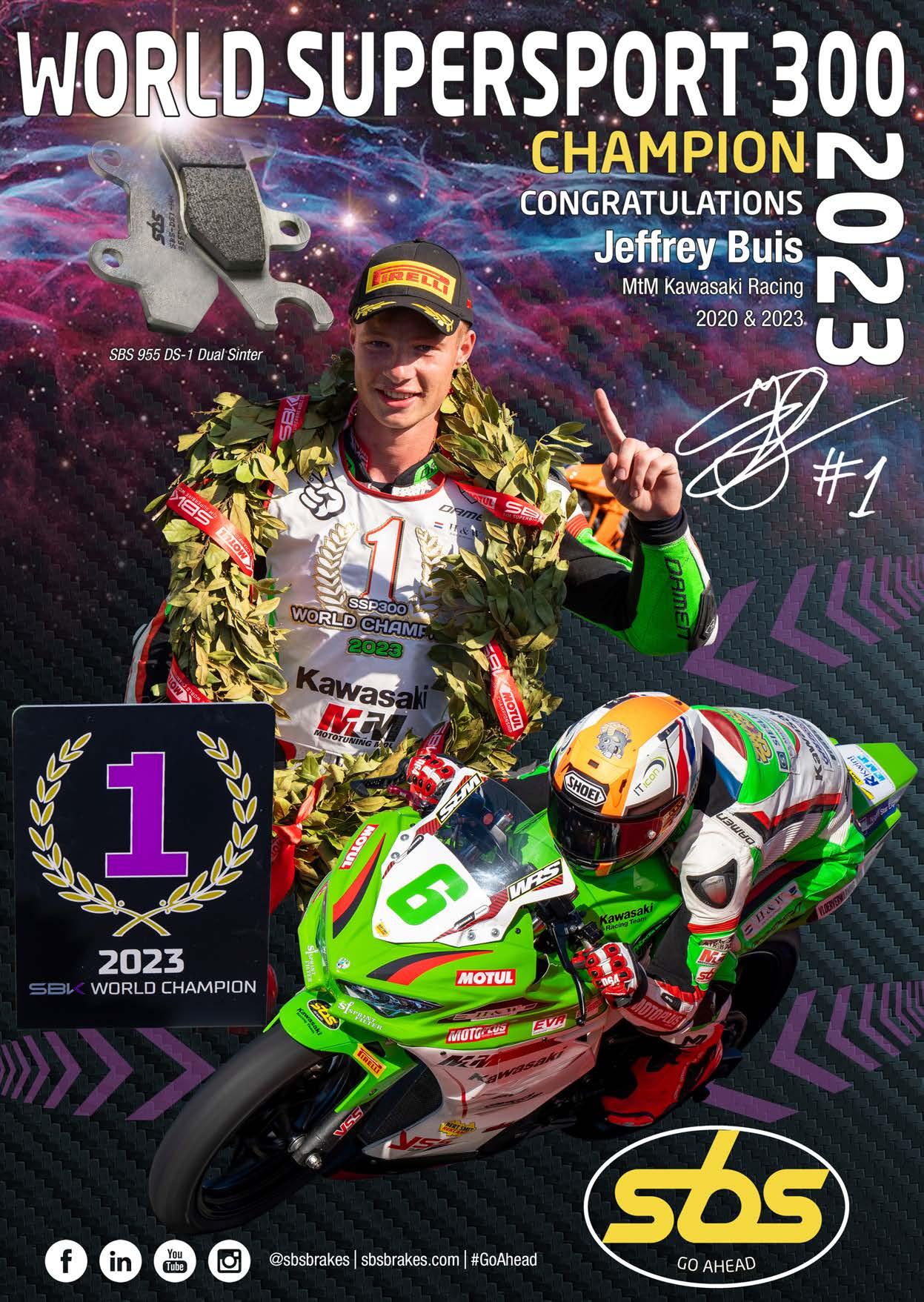
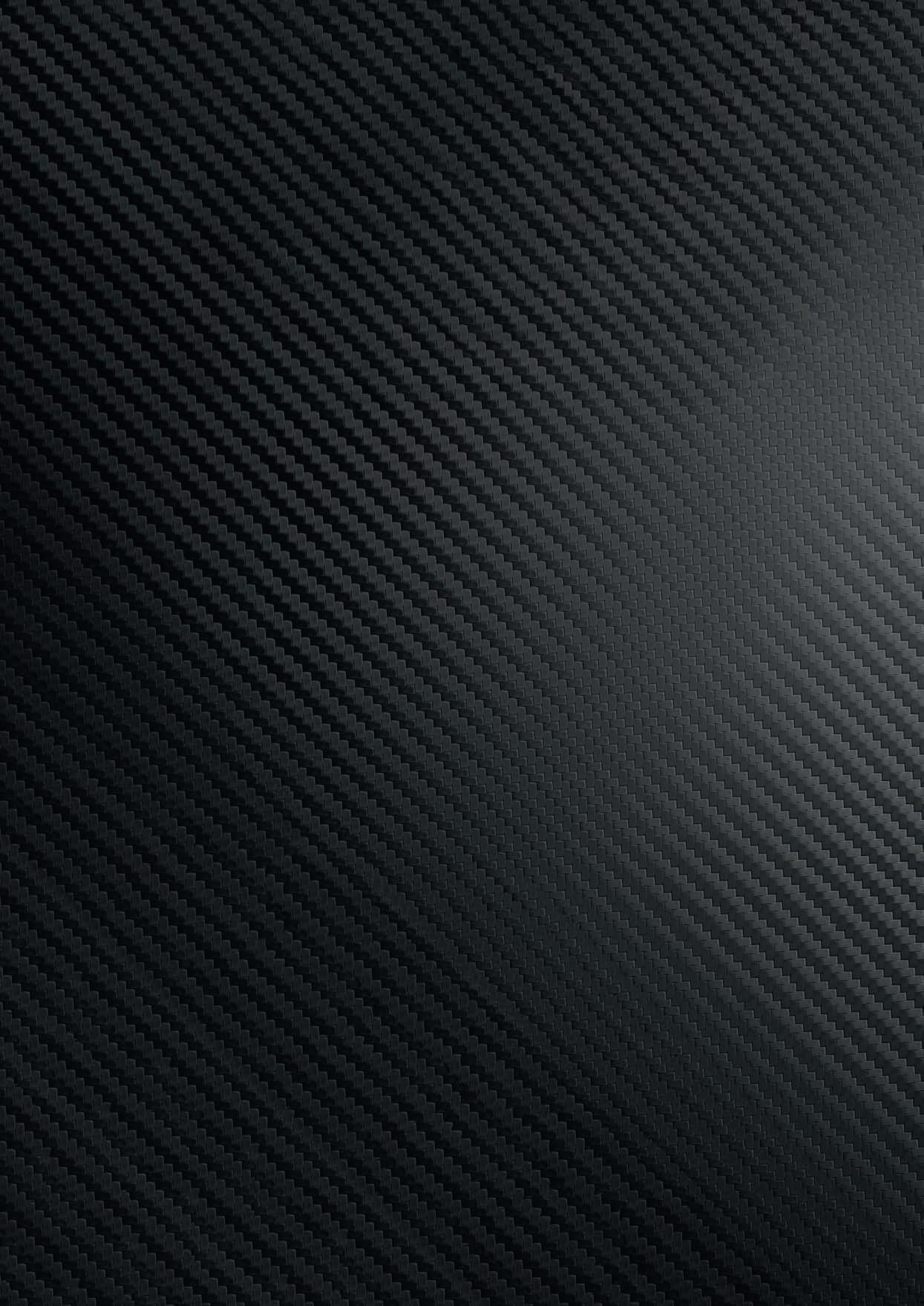




WINS
Unmatched & greatest of All Time






2-TIMES WORLD CHAMPION SUPERSPORT
2-TIMES WORLD CHAMPION SUPERSPORT

SBS racing history started back in the 80s with ceramicbased brake pads that were developed and complemented with sinter brake pads in the 90’s in collaboration with Factory teams such as Yoshimura Suzuki, Ferracci Ducati, Muzzy Kawasaki, Erion Honda and first World Superbike Champion Fred Merkel and Team Rumi Honda.
In the mid-90s, SBS Racing Service became involved in the World Superbike series where the SBS RS Racing Sinter compound was developed in close cooperation between SBS R&D department and the top teams in the Championship.
In 2001, the first DC Dual Carbon version was launched after 5 years of intensive development and testing work.
After several World Champion titles with DC Dual Carbon, the first DS Dual Sinter version was introduced in 2007 after another 5 years of development and testing work.
For the 2019 season, DS-2 Dual Sinter was introduced after several years of R&D work and countless of bike tests performed in World & British Superbike.
In 2020, the newly developed RST compound for Road, Sport & Trackday replaced the RS Racing Sinter compound, extending it into a multi-purpose fitment.
During 2024 season, several DS Dual Sinter pad references was implemented with new “HeRidium” technology for improved backing plate and overall pad stability.
Kenan Sofuoglu
5-TIMES WORLD CHAMPION SUPERSPORT


The DC Dual Carbon and DS Dual Sinter performance has continuously been improved in line with the introduction of new high tech bikes for road racing.
In particular, the Superstock 1000 class with standard braking system made higher demands for brake pad performance simultaneously with the development of engine performance, tire compounds, suspension components and not least electronic riding aids such as traction, wheelie, slide-control, engine-brake, ABS, etc. With these electronic riding aids, lap times dropped step by step, also for hobby and trackday riders.
SBS DC Dual Carbon and DS Dual Sinter have since the turn of the millennium enjoyed great popularity among

top-level teams and riders in World Superbike, Moto 2 & 3 GP, World Endurance and TT road racing and for riders in National Championships and Track-day enthusiasts.
After several World Champion titles in collaboration with SBS ‘Partners in Racing’ teams, first with DC Dual Carbon and later followed by DS Dual Sinter, SBS launched for 2019 season the DS-2 compound to complement the well-known DS Dual Sinter compound.
RS Racing Sinter has been the recommended SBS Trackday brake compound since end of the 90’s. As of 2020 RS has been fully replaced by the sintered RST Road, Sport & Track compound, which is now the recommended brake pad for Trackday use.
DS-1 Dual Sinter
- Strong initial bite
- Linear in-stop performance & brake feel
DS-2 Dual Sinter
- Medium initial bite
- Progressive in-stop performance & brake feel
DC Dual Carbon
- Smooth initial bite
- Controlable and increasing in-stop performance & brake feel
RST Sinter
- Medium initial bite
- Linear in-stop performance
DC Dual Carbon
- Smooth initial bite
- Controlable and increasing in-stop performance & brake feel
As the only manufacturer of racing pads, SBS has since the introduction of DC Dual Carbon in 2001 and DS Dual Sinter in 2007 used NRS technology for both the carbon and the sinter-based compounds.
NRS NUCAP Retention System is an advanced mechanical friction material bonding technology, based on a matrix of steel hooks that are raised from the backing plate steel material. The NRS hooks mold into the friction material,creating an indestructible and corrosion safe mechanical bond without any use of adhesives.


For extreme racing conditions in World Superbike and especially in 24 Hours World Endurance Stock class category, regardless of brake brand used, a well-known brake issue for teams is backing plate stability.
To improve backing plate strength and stability, reduce deformation (bending) and compound taper wear, SBS introduces the HeRidium backing plate technology – an innovative new technology composed of high-tech steel with a specialized heat-treatment.
HeRidium backing plate technology will be used for dedicated DS Dual Sinter brake pad references, see pad drawings page 60-62.
DS Dual Sinter pad references with HeRidium technology, will be labeled with the identifier “HeRi” after the brake pad part number on the backing plate and on packaging labels.



DC Dual Carbon racing brake pads are DEST treated to ensure consistent fade-free performance when leaving from SBS production line. No thermal bedding-in is needed on the bike due to the DEST process which ensures degassing of the carbon based compound to eliminate a gaseous film being created between disc and pad surface to occur loss of brake power (fade).





For combined high-performance road and track bikes.
* State-of-the-art conductive sinter compound formulated for high-performance track use.
* Track Upgrade over high-performance standard brake pads.
* Available for all high-performance standard bike calipers used for Track day & racing.
When changing to SBS RST from using another type of brake pad material - Follow this Bedding-in procedure very carefully:
1. If the brake discs have severe deposit from other brake pad materials than SBS RST, remove this friction material from the brake disc surface using for instance emery paper #150 or a special diamond file tool.
2. New brake pads need about 3-4 laps of gentle braking, until the pad surface is in full contact with the disc surface.
3. When full contact between disc and pad surface is obtained, the pads are ready to race.

* Medium initial bite, firm and consistent brake lever feel in cold and hot conditions.
* Linear in-stop performance & brake feel, easy control and modulation.
* NUCAP NRS technology secures a mechanical and indestructible bonding of the compound.


DC - DUAL CARBON FOR RACE USE ONLY


* The upgrade choice for Superbike, Supersport and Superstock racers in National Championship as well as for Track Day riders
* High-tech carbon compound developed for racing and standard brake systems used for race and sport bikes
* Low heat transfer rate protects brake system and brake fluid against extreme temperatures
When changing to SBS DC from using another type of brake pad material - Follow this Bedding-in procedure very carefully:
1. Remove existing friction material deposit from brake discs - using eg. emery paper#150.
2. Do a series of gentle brakings until pad-surface is in full contact with discsurface.
3. After pad/disc contact is achieved - repeated short brakings building up heat i discs and pads until a very thin and uniform dull/black/darkblue layer of friction material (transfer film) is established on the brake disc.
4. Then a period to allow discs to cool again before proper use.
5. Then a few easy laps building up heat - ready for race use.
* Smooth initial bite, progressive in-stop performance with excellent brake lever feel and modulation
* DEST technology used for pre-bedding of the compound to eliminate fade and secure consistent performance
* NUCAP NRS technology secures a mechanical and indestructible bonding of the compound
When bedding-in procedure IS needed
Always follow the bedding-in procedure - when changing for SBS DC for the first time OR when using new brake discs.
When brake discs are covered by SBS DC friction material (transfer film) - new pads only need about one/two laps to be in full contact with disc surface. Then the pads are race ready (thermal bedding-in as described in the bedding-in procedure in point 1. - 4. is not needed).
When brake discs are covered by SBS DC friction material (transfer film), do not clean/sand/grind the brake discs after each session.
SBS DC Dual Carbon is preferred by many riders due to it’s very smooth initial bite and increasing in-stop performance & feel, to give rider excellent front end feeling with the bike.
World Champions with DC Andrew Pitt, Chris Vermeulen, Karl Muggeridge, Sebastien Charpentier & Ana Carrasco.
World Superbike/Supersport Championship
Double World Champion in World Supersport 600 Sebastien Charpentier from Ten Kate Honda, swore to DC Dual Carbon, but always tried to improve his braking style by testing SBS DS Dual Sinter. He returned though always to DC Dual Carbon since DS Dual Sinter proved too aggressive for him. Sebastien’s results speak for them-selves.
Ana Carrasco – World Champion
In 2018, Ana Carrasco became the first female World Champion ever in road racing at Kawasaki Provec’s Kawasaki 400 Ninja in the World Supersport 300 class, with SBS 955 DC Dual Carbon.
Ana Carrasco has also tested DS-2 Dual Sinter, but prefers SBS DC Dual Carbon’s soft and progressive braking performance to her very smooth riding style, which led Ana to her amazing results in 2018 and again in 2019.
Jeffrey Buis – 2023 World Champion
Same goes for 2020 & 2023 Supersport 300 World Champion MtM Kawasaki rider Jeffrey Buis, whom still prefer DC Dual Carbon with his new 2024 KTM RC 390 & Racing Team Freudenberg.

Ana Carrasco
TEAM KAWASAKI PROVEC RACING “1st FEMALE World Champion ever”



FOR RACE USE ONLY

* The choice of numerous World Champions in Superbike, Supersport, Moto2 and Endurance
* DS-1 is also the preferred choice of most top riders at NW200 & Isle of Man TT
* High-tech sintered compound available for racing & standard brake systems used in racing
1. If the brake discs have severe deposit from other brake pad materials than SBS DS-1 or DS-2, remove this friction material from the brake disc surface using for instance emery paper #150 or a special diamond file tool.
2. The new brake pads only need about one two laps of gentle brakings until the pad surface is in full contact with the disc surface.
3. When full contact between disc and pad surface is obtained, the pads are ready to race.

* Strong initial bite
* Linear in-stop performance & brake feel
* A combination (left and right) of DS-1 & DS-2 compounds makes fine tuning of braking performance possible, see more on page 14 in section “DRC - Dynamic Racing Concept”
* NUCAP NRS technology secures mechanical bonding

For 2024 season, several DS-1 Dual Sinter pad references is implemented with new “HeRidium” technology for improved backing plate and overall pad stability, see page 6.


FOR RACE USE ONLY

* The choice of numerous World Champions in Superbike, Supersport, Moto2 and Endurance
* High-tech sintered compound available for racing & standard brake systems used in racing
* Medium initial bite
1. If the brake discs have severe deposit from other brake pad materials than SBS DS-1 or DS-2, remove this friction material from the brake disc surface using for instance emery paper #150 or a special diamond file tool.
2. The new brake pads only need about one two laps of gentle brakings until the pad surface is in full contact with the disc surface.
3. When full contact between disc and pad surface is obtained, the pads are ready to race.

* Progressive in-stop performance & brake feel
* A combination (left and right) of DS-1 & DS-2 compounds makes fine tuning of braking performance possible, see more on page 14 in section “DRC - Dynamic Racing Concept”
* NUCAP NRS technology secures mechanical bonding

For 2024 season, several DS-2 Dual Sinter pad references is implemented with new “HeRidium” technology for improved backing plate and overall pad stability, see page 6.

SBS DS-1 is preferred by many riders due to its sharp initial bite and linear brake feel.
World Champions with DS-1
Troy Corser, James Toseland, 5-time WSSP Champion Kenan Sofuoglu, Andrew Pitt, Carlos Checa, Michael van der Mark, Adrian Huertas, Álvaro Diaz & double WSSP Champion Dominique Aegerter.
World Superbike/Supersport Championship
At Kenan Sofuoglu’s first titles in World Supersport, powerful initial bite was everything in relation to his riding style. Later, Kenan was involved in the development and testing of the DS-2 as his riding and braking style changed, with his change from Honda to Kawasaki.
In the smaller capacity classes, Scott Deroue who is a former teammate with Ana Carrasco in the MotoGP class Moto3, was very close in the battle for the World Supersport 300 title in 2018 and 2019. Scott is the type of rider who changes into new brake pads before a race, to achieve the absolute sharpest initial bite in the first laps of the race. Scott Deroue prefers the SBS DS-1 on his Kawasaki.
In the smallest capacity class Moto3 World Champion runner up Aron Canet and followed by Romano Fenati in KTM Moto3 and latest Husqvarna Intact GP Factory Team riders Ayumu Sasaki & Colin Veijer, all big fan´s of DS-1´s aggressive initial bite and linear & controllable in-stop brake power – when winning Moto3 races.
DS-1’s powerful and precise initial bite has over the years made DS-1 the most preferred compound among most TT road racing teams and riders at the Isle of Man TT and North West 200 races. The victories and riders of TT road racing speak for themselves: John McGuinness, Ian Hutchinson, Michael Dunlop, Dean Harrison, Peter Hickman, Bruce Anstey, Lee Johnston, Ian Lougher, Conor Cummins, Davey Todd, Alastair Seeley and many more.

SBS DS-2 is the newest dedicated racing compound from SBS and was introduced entering into the 2019 season.
DS-2 is preferred by many riders braking very late and with high pressure not to have a too aggressive initial bite, while at the same time having a good feel and strong build-up of braking power during the stop.
World Champions with DS-2
Kenan Sofuoglu became World Supersport Champion twice with DS-2 during the final development and tests of the compound and most recently young Manuel González became World Supersport 300 Champion, now a regular contender in Moto2 Championship.
World Superbike/Supersport Championship
World Champion Manuel González started the 2019 winter test season with DS-1, but couldn’t really get familiar with the initial bite which did interfer with his bike set-up too much for his riding style. He also wanted more braking power and feel while braking deep into the turns. After testing the DS-2 on his Ninja 400, brake performance was exactly as it should be according to “Manu” - his 2019 championship speaks for itself!

Kenan Sofuoglu
5-TIMES WORLD CHAMPION SUPERSPORT
MotoGP Championship
Moto2 team Intact Dynavolt´s previous top rider Tom Lüthi has been an important factor and test rider in the development of the DS-2. Top priority for him has been controllable braking performance from initial bite in start of braking to end of braking deep inside the corner. Tom used DS-2 Dual Sinter at the very top of the Moto2 championship on his Triumph 765 powered Kalex Moto2 racer.
World Endurance Championship
Throughout the compound test period and the debut season and the years following, DS-2 has also received great popularity among World Endurance teams, with BMW’s Factory Team finishing on the podium at the 2020 season’s first 24-hour race at Bol dÓr with the BMW S1000RR, while also ended 2021 season as vice champions with the all new BMW M1000RR, always equipped with SBS

During the test work for the 2018 racing season, the idea for the SBS DRC Dynamic Racing Concept came up.
With 2 available Dual Sinter compounds with different performance, but with similar wear and temperature characteristics, it became possible to fine-tune and adapt the brake characteristics to the individual rider by combining the DS-1 and DS-2 compounds on the same motorcycle.
Example of racing tests with IDM German Superbike Champion Ilya Mikhalchik, who from his time racing in the Superstock 600 was really pleased with the SBS DC Dual Carbon and its “smooth” initial bite and progressive brake feel.
When switching to a heavier, and much faster Superstock 1000 with standard braking system, Ilya did not feel he had sufficient braking power with DC Dual Carbon. It was therefore obvious to switch the Superstock 1000er directly to the DS Dual Sinter DS-2 which has the same characteristics as the DC Dual Carbon, but at a higher level. Ilya was immediately happy with the DS-2 and was able to recognize the feel of DC Dual Carbon. But after many laps and further optimization on suspension and engine / electronics, Ilya mentioned that he was now missing a bit more “bite” at the start of braking, which in the race language is called “initial bite”. To obtain the desired initial bite, the Dual Sinter DS-1, which has very powerful initial bite, was tested. After a few laps, Ilya came in and announced that “it is too powerful, it affects the fork and bike set-up too much”, then DS-1 in the right brake caliber was replaced with DS-2 and Ilya was sent out to try the combination with DS-1 on the left brake disc and DS-2 on the right brake disc.
Only when the session was over did Ilya come in with the comment “this is exactly how I want the brakes to work”, a combination of DS-1 and DS-2 and thus a fine-tuning of brake performance by combining performance characteristics of the two DS Dual Sinter compounds. This is how SBS DRC Dynamic Racing concept was born.
As a result of intensive test work, SBS is presently the only brake pad supplier that offers a dynamic concept, where complimentary compounds (DS-1 and DS-2) can be used individually with different performance characteristics or used in combination DS-1/DS-2 on left/right brake disc, with the purpose of fine-tuning brake performance according to


DS-1 / LEFT DISC
DS-2 / RIGHT DISC





RQ - CARBON TECH LS - SINTER
* Rear brake carbon compound with high brake performance
* Excellent feel and control to use rear brake steering into turns and handle the bike out of turns
Barni Racing Team WORLD SUPERBIKE
* Rear brake sintered compound with medium brake performance and long pad life
* Recommended for riders using the rear brake occasionally or only slightly entering the turns


SBS Racing receives many questions on how to service the brake system on race bikes.
To achieve perfect braking performance, point 1 is that the braking system must be 100% free of air. Spend the necessary and preferably a little extra time on a serious bleeding of calipers, brake hoses, banjo-bolts & couplings, brake press sensors and master cylinder.
Additionally, keep all parts, especially the brake caliper parts, clean. Use a water/soap solution and a soft brush to keep caliper brake pad slots and pistons clean and tidy from brake pad dust and deposit. Do not use aggressive pressurized brake cleaner products for cleaning brake system internals and seals. After cleaning & drying, add with a soft brush a thin layer of brake grease (ie ATE) to the piston walls and push pistons in/out until all are moving smoothly in/out in the caliper seals.
Brake disc surface should be kept free of too much brake pad material deposit. In case of buildup of deposit particles, surface can be cleaned with a special diamond file as shown in photo.
Bedding-in of brake pads and discs is very important to obtain the best and correct performance, without damaging or destroying any of the parts.
In short, it is about achieving 100% mechanical contact between the brake disc and the brake pad without adding too much thermal and mechanical load to the brake components. This is best done by riding 2-4 slow laps on the track with the sole purpose of braking as easily as possible, as many times as possible without generating heat in the braking system. Even professional riders are often seen braking-in the brake pads in pit lane while entering the track, by repeatedly pulling the brake lever with high pressure all the way out on the track. By doing so, there is a great risk of destroying the brake pads, as some areas
Bobbins/shims/washers/clips in the floating system of the brake discs should be kept clean from brake dust. Use pressurized air eventually brake cleaner product to prevent brake dust and particles to build up and preventing movement of the connecting parts between outer brake disc rotor and inner mounting-hub.
Brake fluid should be interchanged regularly. To avoid fluid related problems like spongy and inconsistent brake lever, flush fresh fluid after every race event. At hard braking circuits, flush fresh fluid after each day.
Always check brake fluid level and the thickness of brake pads before going out on track for a new session.

of the brake pads will glaze-up and become hard and damaged. This is NOT how SBS recommend to perform a good bedding-in of brake pads.
For SBS Racing brake pads, it is important to follow the described bedding-in procedures for each individual compound. RST, DS-1 and DS-2 are quite simple to bed-in if given the above mentioned 2-4 slow and easy laps.
The same applies to DC, but if discs are new or previous used pads are from another compound or type of brand, attention must be given to establish a so-called DC Transfer film on the discs, see bedding-in details for DC Dual Carbon at page 8.
A known issue with the use of sintered brake pads for racing is that the front wheel/discs drag in the calipers. This problem is generated by the sinter material’s good heat transfer properties, which ensures that the heat generated between the brake disc and the brake pad is transferred directly through the friction material to the steel backing plate, after which the heat is distributed to the caliper pistons, brake fluid and the caliper body.
Although brake calipers for race use are one-piece monoblocs the caliper body will expand and flex during use at high temperatures and mechanical load from brake pressure. When the bike is raced on the track and the braking system is hot and constantly exposed to various brake pressures, movement and vibrations from the bike and suspension, there is usually no front wheel/discs drag – this can be inspected quickly when the bike returns to the pit lane by lifting the front wheel of the ground and check that the wheel spins freely.

On circuits (ie GP circuit RedBull Ring) with many subsequent sectors of long hard braking’s from high speed, seeing high temperature and mechanical load to the brake pads. Mechanical stress and tension can occur between the steel backing plate and the friction material which can cause a deformation of the brake pad.
Extensive testing within GP and World Superbike of special samples with thicker backing plates or backing plates with special strength properties, special hardening or annealing of backing plate steel has not improved the properties to obtain the perfect and ideal overall mechanical stability of the brake pad.
Experience from 24-hour World Endurance on hard braking LeMans, has shown that thinner steel backplates with more friction material are more resistant to internal mechanical stress and thus backplate deflection.
When the motorcycle and brake system is cooling, it is often seen on hard brake circuits that the front wheel starts to drag more and more. When completely cooled to ambient temperature it is sometimes seen that the front wheel can be difficult to spin.
Before the bike goes out on the track again, it is recommended to “zero” the brake system by pressing the brake pads and thus the pistons back, by moving the floating discs and pads in/out – until the wheel is turning completely free. Then pump the brake lever until there is again contact between the brake pads and disc, and the brake lever feels firm/hard.
Always a good procedure to “zero” the brake system before going out on track for a new session.
SBS R&D has worked intensively for years and numerously of race dyno-testing has been carried out on various types of backing plate steel qualities and heat treatment combinations.
During 2022 and 23 season the best options from internal testing has been track-tested with top running teams in World Superbike, World Endurance and in the extreme conditions at Asian Superbike Championship circuits as Sepang, Chang and Motegi circuits. Based on the good results with backing plate stability from testing in these championships, SBS implemented in 2024 new backing plate technology named “HeRidium” for DS Dual Sinter pad references found at the pad drawing page 60-62.
For normal use of SBS Racing brake pads, it is recommended for all references to change for new brake pads when approximately 2.0 mm of the friction material remains.
On circuits with heavy mechanical and thermal load on the brake system and brake pads, it may be an advantage to replace the brake pads earlier to reduce the above described bad habits such as front wheel drag and warped backing plates.
On extreme hard braking circuits, we have with great success tested the following minimum thicknesses for brake pads in Racing & High-Performance brake systems:
GP MOTO2 / RED BULL RING / BREMBO:
SBS 845 th = 9.6 mm new, change at 7.0 mm, min friction material th = 3.0 mm
WORLD SBK & BSB / IMOLA & DONINGTON / BREMBO:
SBS 889 th = 9.5 mm new, change at 7.5 mm, min friction material th = 2.5 mm
To be able to identify brake problems or issues experienced from brake performance, it can be a good idea to know in which pressure and temperature range the brake system works on the various circuits.
Data logging is used in many championships, in which logging of brake pressure front and rear is becoming standard. Temperature measurement of brake discs, brake pads and calipers with IR or thermocouple sensors, as well as position and travel of brake lever with potentiometer sensor is possible, but not as commonly used as logging of pressure due to class technical rules limiting the number of channels.
Many teams use so-called temperature sensitive paint on the outer diameter of the brake discs to indicate in which temperature range the brake pads and brake discs work.
Thermal paint kit is available with the following temperature rate:
GREEN > change to WHITE at 430oC
ORANGE > change to YELLOW at 560oC
RED > change to WHITE at 610oC
WORLD SBK / IMOLA & DONINGTON / NISSIN:
SBS 950 th = 10.9 mm new, change at 8.0 mm, min friction material th = 3.0 mm
IDM GERMAN SBK / RED BULL RING / OE STANDARD NISSIN:
SBS 985 th = 7.8 mm new, change at 6.5 mm, min friction material th = 2.5 mm
EU & BSB SUPERSTOCK 1000 / IMOLA & DONINGTON / OE STANDARD BREMBO:
SBS 841 th = 8.1 mm new, change at 6.5 mm, min friction material th = 2.5 mm
BSB BRITISH SSP / DONINGTON / OE STANDARD BREMBO:
SBS 900 th = 8.0 mm new, change at 6.5 mm, min friction material th = 2.5 mm

To indicate the temperature range of the brake caliper and brake fluid, self-adhesive temperature stickers can be used on the brake calipers. The most used sticker range is: 88127oC and 132-171oC.
At LeMans and BoldÓr 24 Hours, SBS Racing Service has used 204-260oC for OEM standard calipers while testing new compounds in Superstock category.

Brake disc prepared with Thermal Paint GREEN (430oC) and ORANGE (560oC).

Brake caliper prepared with temperature stickers.
In connection with above described font wheel drag issues generated by heat transfer from the brake disc and brake pads, it is possible to reduce the heat that causes brake caliper flex and thus inconsistent brake lever, by using socalled brake pad shims or specially designed brake pistons.
Brake pad shims in stainless steel are available and supplied with some OEM standard brake pads. These shims can be used to advantage on the SBS racing brake pads.
For race use, brake pad shims are offered by several manufacturers for most types of standard brake calipers in different designs with the main purpose to reduce contact


area and allow a slight air-stream between pistons/steel backing plate and thereby reduce heat transfer into brake caliper and brake fluid.
There are also specially made pistons for standard OEM calipers for race use. Standard OEM calipers with ie aluminum pistons can be advantageously equipped with pistons in stainless steel or titanium to reduce heat transfer. Also available are piston kits with optimized cooling achieved by special design of cooling holes or a so-called “castellated” contact surface again to reduce the contact area between piston and the brake pad.


Another or additional solution for reducing temperature in the brake caliper and brake fluid is to use so-called brake caliper air ducts, which have gradually become standard with many World Superbike teams. Again, there are many different designs to optimize airflow into the brake caliper around the brake pads.

Brake caliper air ducts are manufactured for the most used standard sportbikes for racing. Most used material is carbon to keep unsprung weight to an absolute minimum.














































































WORLD CHAMPIONSHIP GP - MOTO 2
* American Racing Team
* Intact GP Husqvarna Liqui Moly
WORLD CHAMPIONSHIP GP - MOTO 3
* Intact GP Husqvarna Liqui Moly – 2023 TEAM WORLD CHAMPION
* CIP-Green Power
WORLD CHAMPIONSHIP - SUPERBIKE
* Barni Racing Team
* Kawasaki Puccetti Racing
* Yamaha R3 bLU cRU European Cup
* Yamaha R7 FIM Womens World Championship
WORLD CHAMPIONSHIP - SUPERSPORT 600
* Ten Kate Racing – 2023 TEAM WORLD CHAMPION
* Kawasaki Puccetti Racing
* Althea Racing Team
* Barni Racing Team
* MtM Racing
* WRP-RT Motorsport by SKM-Triumph
* Motozoo MV Agusta Racing
WORLD CHAMPIONSHIP - SUPERSPORT 300
* MtM Kawasaki Racing – 2023 WORLD CHAMPION
* RT Motorsports by SKM
* Team Freudenberg KTM
* Team #109 Kawasaki
* ARCO Motor University Team
* Deza-BOX77 Racing Team
* Yamaha MS Racing
WORLD CHAMPIONSHIP ENDURANCE
* Tati Team Beringer Racing
* Team Bolliger Kawasaki Switzerland
* RAC41 ChromeBurner Honda
* TECMAS BMW Racing Team
WORLD JUNIOR CHAMPIONSHIP
* Intact GP Moto2 Junior Team – 2023 WORLD CHAMPION
* CIP Racing Junior Team
BSB BRITISH SUPERBIKE CHAMPIONSHIP
* PBM Ducati – 2023 CHAMPION
* OMG Yamaha Racing
* FS-3 Kawasaki Racing
* FHO Racing BMW
* Honda Racing UK
* Synetiq TAS BMW Racing
* Hawk Honda Racing
* DAO Racing
* Padgetts Racing
MA MOTO AMERICA CHAMPIONSHIP
* N2 Racing – 2023 CHAMPION
* Team Hammer Racing
* S&S Cycle Racing Team – King Of The Baggers & Super Hooligan 2023 CHAMPION
* Tytlers Cycle RideHVMC Racing
* Altus Motorsports
* Mesa37 Racing
* MP13 Melissa Paris Racing
* Kayla Yaakov Racing
* Geoff May Jones Honda Racing
IDM GERMAN CHAMPIONSHIP
* RT Motorsports by SKM – 2023 WINNER
* Alpha Racing-Van Zon-BMW
* GERT56 German Endurance Racing Team
* Team Freudenberg KTM
CIV ITALIAN SBK CHAMPIONSHIP
* Barni Racing
CEV SPANISH CHAMPIONSHIP
* Deza-BOX77 Racing Team – 2023 WINNER
* ARCO Motor University Team – 2023 WINNER
* Yamaha MS Racing
* BMW 1000 RR Iberia Cup
FRENCH SBK CHAMPIONSHIP
* TECMAS BMW Racing Team – 2023 WINNER
ARRC ASIAN ROAD RACING CHAMPIONSHIP
* ONEXOX BMW TKKR Team – 2023 WINNER
* Kawasaki Racing
* ZK Racing
TT & INTERNATIONAL ROAD RACES
* Peter Hickmann – 2024 IoM TT Superbike & NW200 Supertwin WINNER
* Michael Dunlop – 2024 IoM TT Supersport & Supertwin WINNER
* Glenn Irwin – 2024 NW200 Superbike WINNER
* Davey Todd – 2024 NW200 Superstock & Supersport + IoM TT Superstock & SeniorTT WINNER
* Richard Cooper – 2024 NW200 Supersport WINNER
* Dean Harrison
* John McGuinness
* Nathan Harrison
* Josh Brookes
* Conor Cummins
* Ian Hutchinson
* Davo Johnson
* Alastair Seeley
MACAU Grand Prix
* Peter Hickmann – 2023 WINNER
CLASSIC ENDURANCE EU CHAMPIONSHIP
* Team Force
* Road Runner Team
* Phase One Sweatshop
DUTCH SBK CHAMPIONSHIP
* Wayne Tessels – 2023 CHAMPION
DANISH SBK CHAMPIONSHIP
* August Kroon – 2023 CHAMPION
SWEDISH SBK CHAMPIONSHIP
* Jesper Pellijeff
DANISH & SWEDISH SUPERMOTO CHAMPIONSHIP
* Simon Vilhelmsen – 2023 CHAMPION
STUNT MASTERS CUP
* Mike Jensen – WORLD CHAMPION

